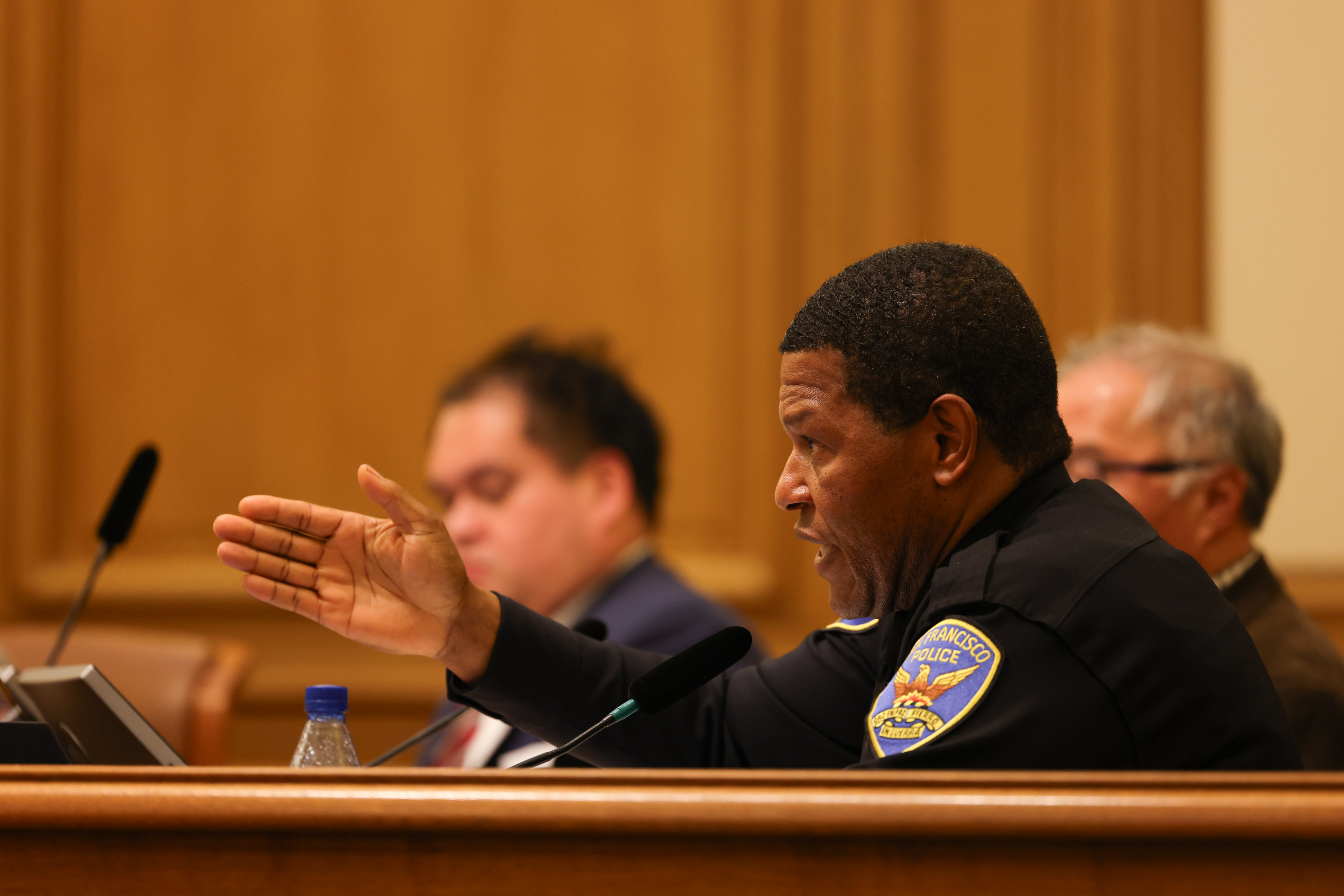San Francisco police say they planned to stop the spontaneous skateboarding event known as the Dolores Park Hill Bomb because of concerns from former incident commanders, neighbors and some in the skateboarding community about the event’s increasing violence and destruction in recent years.
The department’s plans and actions around the July 8 mass arrest were relayed Wednesday to the city’s Police Commission by Chief Bill Scott before he gave an account of the night, including slow-motion clips of bottles, cans and fireworks being thrown at police.
“Several people said you really should not allow this to happen because somebody is going to die again,” Scott said. “We went into it trying to prevent the Hill Bomb from occurring. … This is not the same event (as) when it started.”
For a number of years the unsanctioned skateboarding event played out on the steep downslope of Dolores Street where mostly young people hurdle toward 18th Street as onlookers gawk at feats that often end in falls and injuries. Police have always shown up to the event, but never in the numbers seen last week.
The recent Hill Bomb resulted in 115 arrests—83 of them juveniles—and the retrieval of a number of guns, knives, fireworks and spray paint. It also led to a debate about how best to respond to such spontaneous events in the future.
Some criticized the police response as a heavy-handed action aimed at mostly youth skateboarders already prone to mistreatment by authorities. But others praised the police for taking a hard line on an unplanned and increasingly out-of-hand event.
Many of those critics continue to ask why the department didn’t better plan its response as it had with other unpermitted events like the Dyke March, which it prepared for with robust public outreach ahead of time.
Commissioner Kevin Benedicto asked if the department had reached out to anyone in the skateboard community or notified the public on social media or other platforms that the event would not be allowed to proceed.
Chief Scott acknowledged that the department had started planning its response to the event as early as June because police expected that it would happen in July as usual. But he said the department only found out that the event would happen three days before it occurred via social media.
Scott also said the department spoke to some of the originators of the event, who told the department the event should be shut down.
While the department beefed up its presence, Scott said the hope was that people would leave so no arrests would be necessary.
Instead, according to the department’s detailed account of the event, the incident was declared unlawful after the crowd got violent. The chief said attendees threw a bottle, a can and at least two fireworks at officers, one of whom was spat on and scratched on the face.
Unlike in past years, the crowd ignored repeated dispersal orders and instead spread out around Dolores Park before vandalizing Muni buses and trains with passengers inside, according to video presented by the department and at least one live clip from a video crew on the scene.
A video crew on the scene captured vandals spray-painting buildings and scrawling tags and climbing atop Muni trains.
The 80-plus officers in riot gear walked slowly in lines toward the crowds, eventually firing 15 rounds of foam bullets when they reached Church, 18th and Dolores streets just past 8 p.m., Scott said.
By 8:43 p.m., police began arresting more than 100 people at 17th and Dolores streets, according to the chief.
In the roughly two hours after the dispersal order, video reviewed by The Standard shows the neighborhood devolved into chaos. Aside from the vandalism and violence, the department said a sideshow occurred blocks from the event and that it received a report of gunfire. The city, meanwhile, has said the damage from graffiti and other vandalism was extensive.
Most of those arrested were minors, and Scott said his officers treated them differently than adults, from whom they were separated, as were girls from boys. He also said that they were each given arrest cards advising them of their rights and ultimately released to their parents or guardians.
Most of the youth arrested were boys, Scott said; nearly half—42—were Latino, and 18 were white.
Four people have been charged for their actions that day, Scott said.
The chief said the department has no reports of anyone being injured by police, but at least one participant told a film crew at the scene that a foam bullet had struck his abdomen.
After being questioned by a commissioner, Scott admitted that minors who may have had nothing to do with illegal activity were caught up and arrested.
“We heard from community members that some youth were trying to leave,” Police Commission President Cindy Elias said, citing reports that many minors who did nothing illegal were detained for hours after trying to leave the area as ordered.
The chief admitted that minors were zip-tied and many waited a long time before being released, but said the situation was dangerous, violent and unusually chaotic.
One of several minors arrested at the event who spoke to the commission Wednesday said he and many others felt frightened and abused by police.
“I was at the Hill Bomb,” San Bruno resident Max Ruiz said. “A lot of them were scared and vulnerable. I don’t know why the police treated us the way they did.”
The department plans to review its actions in relation to the mass arrest of so many minors, especially whether or not youth urinated on themselves because they were barred from using bathrooms.
